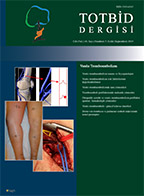
Major orthopaedic surgery is, by definition, a high risk procedure for venous thromboembolism. Since venous thromboembolism may cause complications that may lead to mortality which includes fatal pulmonary embolism, prophylaxis is mandatory to avoid/reduce these complications. Venous thromboembolism prophylaxis can be studied in two complementary sections: pharmacological and mechanical. Components of mechanical prophylaxis are: early post-operative mobilization, gradual compression stockings, intermittent pneumatic compression devices and venous foot pumps. The use of mechanical prophylaxis methods is strongly recommended in major guidelines, even though the evidence levels are medium to weak. If possible, the use of all of them (early mobilization, ankle movements, gradual compression stockings and intermittent pneumatic compression devices) in addition to pharmacological prophylaxis have the effect of reducing deep vein thrombosis and related pulmonary embolism.